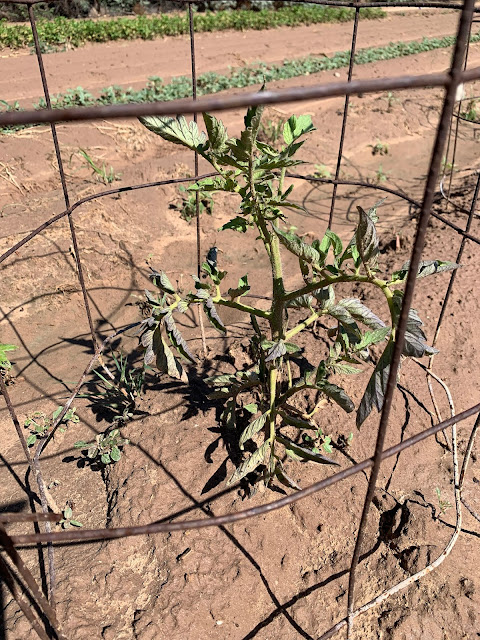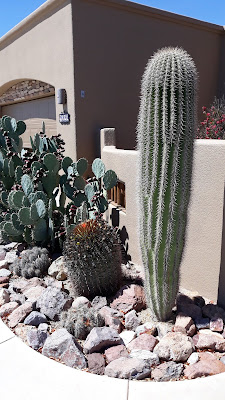Straight Answers to Curly Questions
Southwest Yard & Garden
Curly Top Q&A
Dr. Marisa Thompson

This tomato plant is suspected to
be infected with the curly top virus and will likely never grow large enough to
fill its cage. Note the stunted size, yellowing stems, and curled leaves with
purple venation. Photo credit Marisa Thompson.
Last week, I attended an online conference with a few dozen researchers who all had one thing in common: they all study the curly top virus. Some of them were virologists who work on all kinds of viral pathogens. Others were entomologists who study how the virus is transmitted from plant to plant via the beet leafhopper. Some study this virus specifically in sugar beet production. Others study how it affects spinach or chile. This summer at the NMSU Agricultural Science Center at Los Lunas, we’re studying tomatoes, another curly top victim, and how shade cloth might help home gardeners by either protecting plants from the tiny, jumping insect vector (tiny, as in a skinny grain of rice) or by reducing sun and heat stress on the plants and thereby reducing water requirements.
I’m lucky to have a dedicated team
of volunteers who are helping with the tomato study fieldwork. At the curly top
research meeting, I presented our work and asked the experts to answer
questions from the volunteers. For this week’s column, I’ve selected a few that
I think readers will find interesting and, hopefully, useful in their own
gardens.
Before I get into the Q&As, we
need more background on the virus, the plants affected, common symptoms, the
insects that spread it, and where these insect vectors live. The following
excerpts were taken from the newly revised NMSU Extension Guide H-106, titled “Curly
Top Virus” (https://aces.nmsu.edu/pubs/_h/H106/)
by Dr. Natalie Goldberg and Phillip Lujan.
“Curly top virus (CTV), or beet curly top virus (BCTV) as it is
more formally known, is widespread throughout arid and semiarid regions of the
world. The virus is common in the western United States from Mexico to Canada
and in the eastern Mediterranean Basin. The virus has a wide host range,
causing disease in over 300 species in 44 plant families. The virus appears to
be restricted to broadleaf plants because no monocotyledonous plants have been
identified as hosts for this virus. The most commonly infected hosts include
sugar beets (for which the disease was first named), tomatoes, peppers, beans,
potatoes, spinach, cucurbits, cabbage, alfalfa, and many ornamentals. The virus
also survives in many weeds, such as Russian thistle (tumbleweed) and mustards
(London rocket and flixweed).
“Symptoms vary depending on the host; however, this disease
produces some general symptoms such as curling and twisting of the leaves…
Severity of disease is also dependent on the age of the plant when infected.
For example, when young plants are infected they will often die shortly after
infection. When plants are infected after the seedling stage, the plants
survive but are yellow and stunted. Infected leaves of some hosts, particularly
tomatoes and peppers, become thickened and crisp or stiff, and roll upward as
the petioles curve downward. The leaves turn yellow with purplish veins. Leaves
of other hosts such as beets become very twisted and curly. In most cases, yield
is reduced, and the fruit that is produced ripens prematurely. The immature,
dull, and wrinkled fruit is a good diagnostic symptom for tomatoes infected
with CTV. If plants are infected after they have begun to set fruit, it is not
uncommon to see infected and healthy fruit on the same stem.
“This disease is transmitted (vectored) from infected to healthy
plants by a small insect called the beet leafhopper (Circulifer tenellus). The leafhopper is an effective vector because
it is able to transmit the virus after feeding on an infected plant for as
little as one minute and can subsequently transmit the virus for the remainder
of its lifetime (persistent manner). The virus is not passed on to leafhopper
progeny.”

Top and side view of beet leafhopper (Circulifer tenellus), vector of curly top virus. Photos from NMSU Extension Guide H-106, “Curly Top Virus” (https://aces.nmsu.edu/pubs/_h/H106/).
Because the beet leafhopper is known to feed on several common weeds, weed control is a recommended way
to make your yard, garden, or fields less hospitable for new generations of
this pest.
More from the aforementioned NMSU
Extension publication: “There are no chemicals available for controlling the
virus, but several cultural practices can help reduce or eliminate infections.
Although resistance to curly top is not known, growers may benefit from
planting several different cultivars since some may be somewhat tolerant of the
virus. Good sanitation practices, such as weed and insect control, are also
essential for limiting the occurrence of the disease. Home gardeners may also
consider planting susceptible hosts, such as tomatoes and peppers, in a
slightly shaded part of the garden since leafhoppers prefer to feed in sunny
locations. If the garden is in full sun, it may be helpful to place a netted
cage over the plants when they are young. This netted material will provide a small
amount of shade and, if the holes are small enough, will provide a physical
barrier to prevent leafhoppers from getting to the plants.”
Again, more details can be found by visiting https://aces.nmsu.edu/pubs/_h/H106/. And you can find several related Southwest Yard & Garden columns listed below the following Q&As.
Question: Can other insects also transmit the virus?
Answer: No. While other insects
may ingest the virus when feeding on your plants (I’m looking at YOU, tomato
hornworm), they do not harbor the virus or transmit it to other plants.
Question: Can the virus be transmitted by human touch?
Answer: We can all breathe a sigh
of relief on this one because the virus is not transmitted by touch or by
pruning shears either.
Question: Can infected plants be asymptomatic?
Answer: Yes! Whether or not
symptoms fully develop is particularly dependent on both the plant's growth
stage when it becomes infected and by how healthy the plant is. Healthy,
unstressed plants that are infected later in the season may be big and strong
enough by then to fight off the infection on their own and still produce a good
crop.
Related Columns from Years Past:
Tomato curly-top virus, Aug 1999 by Dr. Curtis Smith
Beet leafhopper/curly top virus outlook, April 2003 by Dr. Curtis Smith
Can last year's seeds cause curly-top virus problems this year? Feb 2008 by Dr. Curtis Smith
It is ok to compost tomatoes that had curly top virus, Sept 2008 by Dr. Curtis Smith
Numerous things that can stunt garden plants, May 2011 by Dr. Curtis Smith
Curly Top Virus: Hints for Healthy Tomatoes, Feb 2018
Undercover Tomatoes: Beating the Beet Leafhopper and Avoiding Curly Top Virus Infection, May 2019
Tomato Flavor: Where Did it Go and How They’re Bringing It Back, Aug 2019
Tomato Warning: Side Splits and Shoulder Cracks, Aug 2020
For more gardening information, visit the NMSU Extension Urban Horticulture page at http://desertblooms.nmsu.edu/ and the NMSU Horticulture Publications page at http://aces.nmsu.edu/pubs/_h/. Find your local Cooperative Extension Office at https://aces.nmsu.edu/county/.
Marisa Y. Thompson, Ph.D., is the Extension Urban Horticulture Specialist in the Department of Extension Plant Sciences and is based at the New Mexico State University Agricultural Science Center at Los Lunas.


Comments
Post a Comment